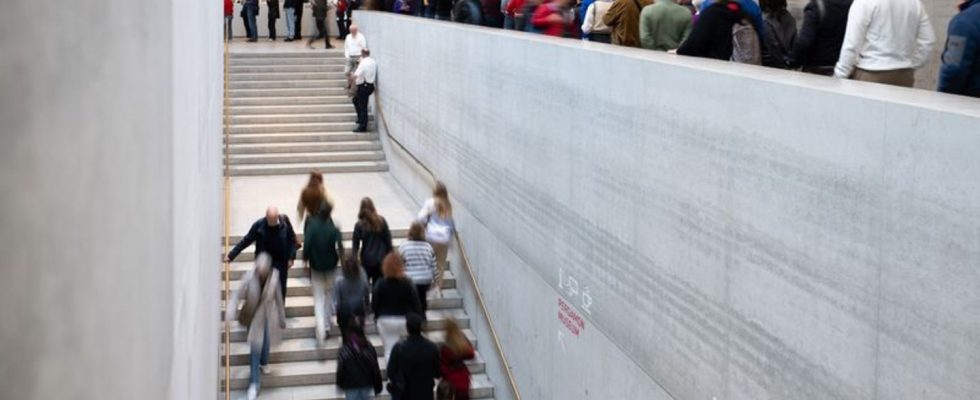Cultural institution
Huge Prussian foundation undergoing structural change
The houses of the Prussian Cultural Heritage Foundation – such as the Pergamon Museum here – are a crowd puller with around four million visits recently. photo
© Sebastian Christoph Gollnow/dpa
Among cultural institutions, the Prussian Cultural Heritage Foundation is considered a huge tanker with four million visits. But also a bit sedate. The structural reform promises more flexibility.
The houses of the Prussian Cultural Heritage Foundation are a crowd puller with around four million visits recently. Nevertheless, Germany’s largest cultural institution is considered too sedate and its international appeal can be expanded. The break-up that was initially discussed is off the table; a comprehensive reform should make the SPK more agile.
“The transformation of the SPK is very much about the autonomy of all houses,” said Foundation President Hermann Parzinger of the German Press Agency Berlin. “In the future, every museum and institute of the state museums will be on an equal footing with the other institutions of the foundation. The SPK will therefore be a large network of institutions that should act as autonomously as possible; we want to move away from a centralistic structure.”
4.7 million objects
In addition to the state library and several institutes, the foundation, which is supported by the federal and state governments and has around 2,000 employees, also includes state museums such as the Neue Nationalgalerie, Pergamonmuseum, Hamburger Bahnhof, and Gemäldegalerie with 15 collections and 4.7 million objects at 19 locations.
During the reform, for example, five museum teams will be formed to take over the tasks of the previous general directorate. According to Parzinger, every house actually needs such teams. “But we have to be realistic; that cannot be achieved even with financial growth.” The teams are intended to increase the effectiveness and autonomy of the museums.
“What do we want to stand for in the future?”
From January onwards, every state museum house will receive a budget like the state library, which is also part of the SPK. “The budgets are of course very small at the moment because so much cannot be distributed in the current budget situation,” said Parzinger. There is a distribution key to do justice to all houses. “For the first time, the museum directors can decide for themselves whether they use their budget to pay for business trips or whether they invest it in exhibitions or other projects. Of course, no museum can hold large exhibitions on its own. But it is an important starting point for the management of museums and institutes , which previously always had to be negotiated with the general director and among the directors.”
The SPK boss is already seeing progress. “Since museums have been able to operate more freely, there has been more cooperation. We have great people who we want to use their potential to act more independently.” There should be a strategy for the entire network of 25 SPK facilities. “Of course we are concerned with the question, what do we want to stand for as an association in the future?” says Parzinger. “We have defined areas of impact and want to develop very specific measures starting next year.”
“Large tanker, mobile sailing ships”
Minister of State for Culture Claudia Roth is confident. “The foundation is a large tanker from which a variety of slim and agile sailing ships are now being created,” said the Green politician, who also chairs the SPK Foundation Board, to the dpa. “In my view, a complete break-up would have been a mistake because then the small but fine institutions would have been really marginalized.” Now there is a shared house with individual apartments. “The proximity is created through the autonomy of the facilities and this also frees up creative spaces.”
Roth sees a “fascinating creative impulse” and points to the development “which makes it attractive for the federal states.” She wants more impact. “The foundation is a lighthouse, a flagship for culture, for Germany as a cultural nation. This lighthouse could be much better known, the SPK could play the Champions League at world level and attract even more people.”
The reform is expected to increase the need for financing. The foundation’s budget was recently at a good 380 million euros. The state shares have been capped since 1996. All countries together contribute around 15 percent of the budget, around 8 percent of which is Berlin as the host country. The federal government pays around 85 percent.
“So far there has been an offer from the states, they want to increase it by ten percent,” said Roth. “Since the federal states’ contribution of 30 million is, to be honest, very manageable, a ten percent increase of three million is really not enough. What is important now is that the attractiveness of this reform process, of the realignment, has to jump out at you, so to speak Every individual federal state can also benefit from this by having the foundation also be active in federal states or by setting up programs that specifically include a perspective from individual federal states.”
Greater perceptibility and visibility
Joe Chialo is the Senator for Culture in Berlin. “The foundation has really achieved a lot and done a great job,” said the CDU politician to the dpa. “Now it’s about securing the whole thing financially.” He sees major challenges not only in Berlin. “There is also massive struggle in the federal government and in other federal states to bring the budget together.” Chialo: “It is of course the desire of the countries to combine this ten percent to a certain extent with greater visibility and visibility.” There is a strong focus on Berlin, which is definitely justified. “But I do believe that we have to make sure that all countries feel seen or noticed. We have to make adjustments accordingly.”

